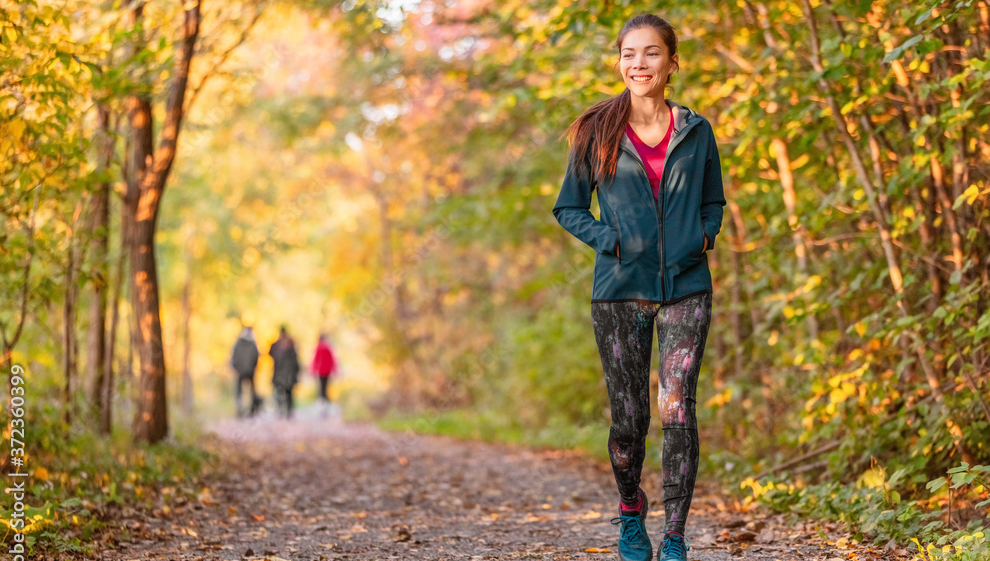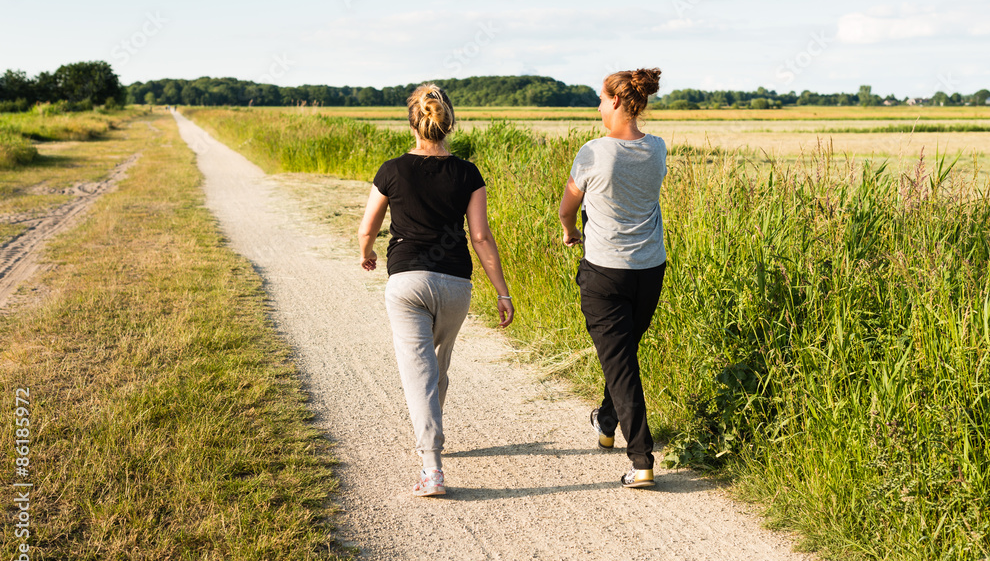Why walking is so good for us and how to get started
- Overview
Unsure how to get started? Worried you’re too slow? Don’t be. You don’t need fancy equipment or the latest kit to make walking part of your daily routine. The best part is that almost everyone can start where they’re at and build up their activity levels over time.
Key takeaways
- The NHS recommends a minimum 150 minutes of moderate activity per week for adults
- Walking at a brisk pace is an accessible activity that counts towards this goal
- We all start in a different place, so start with a pace and distance that’s comfortable for you
- There are many ways to up your step count and walk more throughout the day
- Charting progress over time is a great way to maintain motivation and build confidence
- Counting your steps introduces a light-hearted challenge element to your walking
Why walking is a great form of exercise
Walking is often disregarded as “not exercise”. The reality is that this couldn’t be further from the truth.
Keeping a decent pace and setting a goal distance for your walk is a great way to incorporate movement into your daily routine. Walking can even form part of your 150 minutes of moderate activity per week as recommended by the NHS.
Here are some of the reasons why we love walking as a physical activity:
- It’s accessible
- There’s plenty of ways to track progress
- You don’t need fancy equipment
- You can get started right away
- Increasing distance or speed gives you something to work towards
How to get started
Start with a pace and distance you’re comfortable with. What this looks like for you will all depend on your current physical activity level and time constraints.
You’ll also want to define your goals for walking. For some people this will be to lose weight and get more active, whereas for others (those recovering from an injury or with little to no physical activity in their routine currently), walking may form part of a wider rehabilitation programme or basic fitness regime.
You’ll quickly be able to find what works for you and what feels like you’re pushing too hard. Whether you’re walking for 15 minutes a day or starting out with a 5km hike, finding what’s initially comfortable for you will give you a strong base to build on over time.
If you feel exhausted the next or after returning from a walk, you may need to adjust your routine, distance or pace ahead of your next one.
Stick to terrains you’re comfortable with

Depending on where you live, you’ll find loads of different environments to go walking in.
As the old saying goes, don’t run before you can walk. If you’re getting started and aren’t 100% confident, avoid uneven terrain and stick to the pavement until your balance and confidence improves. Eventually, you may want to introduce some trails or grassy walks to mix things up a bit.
The same goes for hills. Hills can put extra strain on your hips, back, and knees (going up and coming down) so it’s best to avoid them for a bit whilst you find your feet.
How much should I be doing?
This depends entirely on your goals.
Walking has benefits for both experienced athletes (walking can work great as part of an active recovery routine) and those simply looking to introduce more movement into their daily routine.
The best way to get started is to simply get out there and increase your distance over time. If you suffer from joint pain or are recovering from an injury, start small and pay attention to how your body feels during and after your walk.
Don’t push yourself too hard initially if you’re new to walking. Over time, you’ll learn how your body reacts to movement, when to do more, and when to prioritise rest and recovery.
Things to consider
Consider the following when you’re determining how far and how often to walk:
- What your current activity levels are
- Whether you have joint pain
- Whether you have a pre-existing health condition
- Fatigue and tiredness levels
How fast should I be going?
If you’re getting started with walking or have mobility problems, speed shouldn’t be something you worry about or need to consider. Concentrate instead on getting out and about in the fresh air on a regular basis to increase the amount of daily movement you’re getting.
If you’re looking to make walking part of your moderate exercise for the week, you should be moving at a pace where you’re able to hold a conversation but unable to sing the words to a song out loud. Speed will vary from person to person depending on your current ability, however a brisk walk should have you moving at around 3 miles an hour.
If you're getting started, don't let talk of speeds and steps put you off. The most important thing is that you keep up your commitment to make walking part of your daily routine in a way that works for you.
Building things up over time
No matter what your ability, walking is a great way to get you moving more and more. The best part is that you can build up time and distance at a pace that works for you as you progress day by day.
Because there are so many ways to walk and speeds to do it at, making progress ends up happening naturally. You don’t have to learn any new techniques, you’ll just end up getting faster as your fitness increases.
Over time, many people even end up making the transition from walking to jogging and even running. Walk/run programmes like Couch 2 5k are a great way to do this.
Others find that walking is for them and that increasing time, distance, and the amount of incline they’re able to walk against increases over time.
Find a routine that works for you
One of the most important elements of any exercise and movement routine is consistency. Keeping things going over time helps build healthy routines that last for life.
Consistency is all about finding ways to exercise and get moving that work for you. What this looks like will vary from person to person and all depends on your existing work/life routine, how much time you have to play with, and other commitments that occupy your time.
Thankfully, there are ways you can up your step count and introduce brisk walk into your day. Some great ways to make time include:
- Walking the dog
- Doing the shopping
- Taking a brisk walk after work
- Walking on an incline treadmill at the gym
- Working an active job
- Take a walk whilst you’re on a work call
- Going for a walk on your lunch break
- Taking the stairs instead of the lift
- Getting off the train or bus early to walk the rest of the way
What time of day is best?
This depends on your routine, environment, and your reasons for getting more active. For those wanting to improve sleep quality, getting out first thing in the morning and exposing yourself to light as early as possible can positively impact your circadian rhythm and sleep cycle.
In the summer, you might want to avoid the midday sun and opt for a leisurely evening stroll instead. In winter, the opposite rings true because of reduced daylight hours.
If you’re working during the day, getting up early and taking the dog for a walk means you have more free time in the evening to enjoy yourself. Other people actually enjoy a brisk walk to decompress after a day at work.
You may find that something you previously didn’t enjoy (getting up an hour earlier to take a morning walk) eventually becomes part of your new routine. The best thing you can do is to experiment and find what works for your mental and physical wellbeing.
Changing things up over time
As your fitness increases and you become more comfortable, you might find you naturally start to walk faster.
If this happens to you, you might want to investigate activities like hiking, Nordic walking, and speed walking to introduce a more intense element to your walking schedule.
If you’re looking to meet the NHS guidance on physical activity for the week, upping the intensity of any physical activity can help make this easier. Shorter, more intense sessions (often labelled “vigorous”) mean you exercise at a faster pace (your heart rate will be higher and you’ll find it more difficult) over a shorter period of time.
Once you feel ready, introducing some more challenging days (gentle hills are a great place to start) can help keep movement fresh and challenge your body in new and exciting ways.
Finally, it’s important to note that you don’t have to add intensity or increase your speed. If you’re comfortable walking at a pace that works for you, you can make your walks longer if you want or stick with what feels good for you.
Step counting and why it’s so beneficial
Counting your steps using your smartphone or smartwatch is a great way to make walking fun and engaging. Setting yourself challenging yet attainable step-counting goals can turn a monotonous walk into more of a game that keeps you coming back day after day.
A smartwatch or step counting app will allow you to look back over previous days to see how far you’ve come since you got started. This is a great way to build confidence in your own ability and maintain motivation over time.
You can even get your friends and family involved too to make a light-hearted competition out of step counting!
Interested in step counting? Click here to get started
How important is diet?
Healthy nutrition habits and eating a balanced diet should be a priority for us all.
It’s not necessary to make major dietary adjustments if you’re introducing a new walking routine, however a diet that’s low in processed options and high in macronutrient-rich foods will help give you the energy you need (both physically and mentally) to start and maintain new healthy habits.
Unsure about what a healthy diet looks like? Click here to learn more
Can walking benefit my mental health?

Absolutely. Walking is a great way to boost self-esteem and build a strong connection between your physical and mental well-being.
Engaging in regular physical activity (no matter how intense) can trigger the release of endorphins which boost our mood and heighten feelings of happiness whilst we’re moving. Outdoor walks that expose us to natural light are even better for this, as natural sunlight on our skin is proven to elevate our mood.
Additionally, walking also cultivates a sense of achievement and confidence, both of which can contribute to improved self-esteem and confidence.
Do I need any equipment to get started?
The number one rule for walking is that you need shoes that are comfortable. The same goes for the clothes you choose to wear when you’re heading out.
These don’t need to be the most advanced running shoes by the most fashionable brand – just make sure that what you’re wearing is comfortable and suited to the temperature and conditions outside.
Most people find a cushioned pair of gym or running trainers perfectly fine. If you suffer with joint pain, a comfortable pair of shoes will help support your arches and gently cushion your feet to take the strain off your ankles, knees, and hips.
Fun apps and resources
Smartphone apps
The best UK walking trails
- The best walking trails in the southwest of England
- The best walking trails in the southeast of England
- The best walking trails in the Midlands, Yorkshire, and Humberside
- The best walking trails in northwest of England
- The best walking trails in the northeast of England
- The best walking trails in Northern Ireland
- The best walking trails in Wales
- The best walking trails in Scotland
Last updated Thursday 11 April 2024
First published on Thursday 11 April 2024

